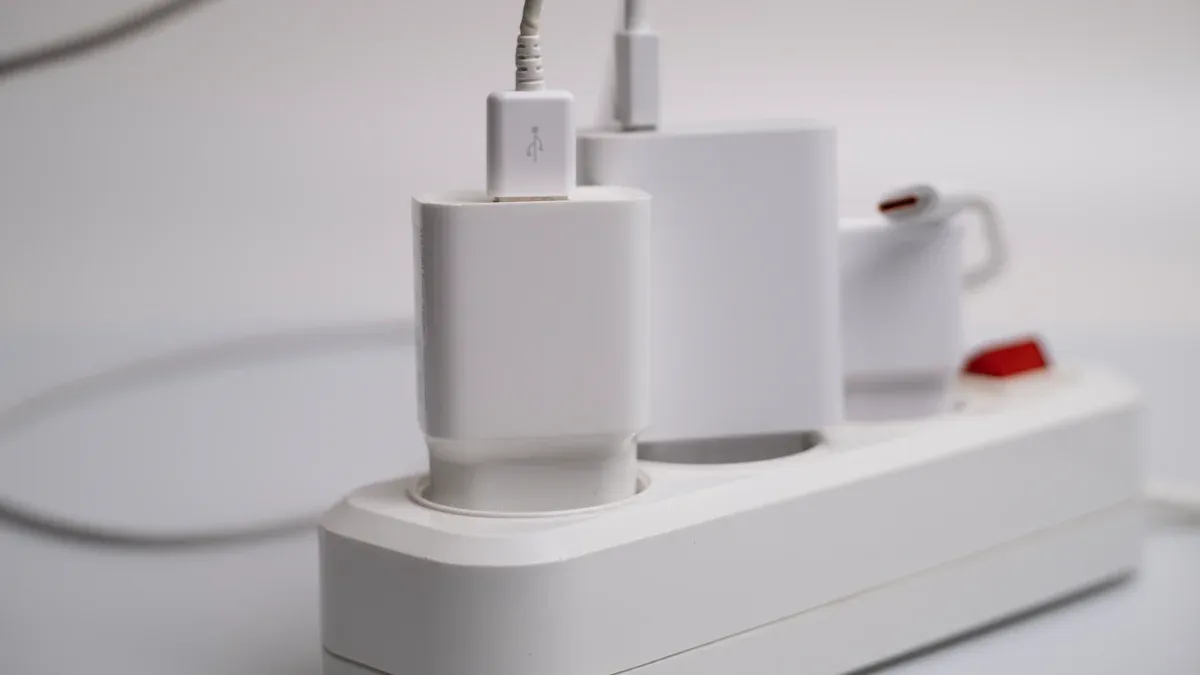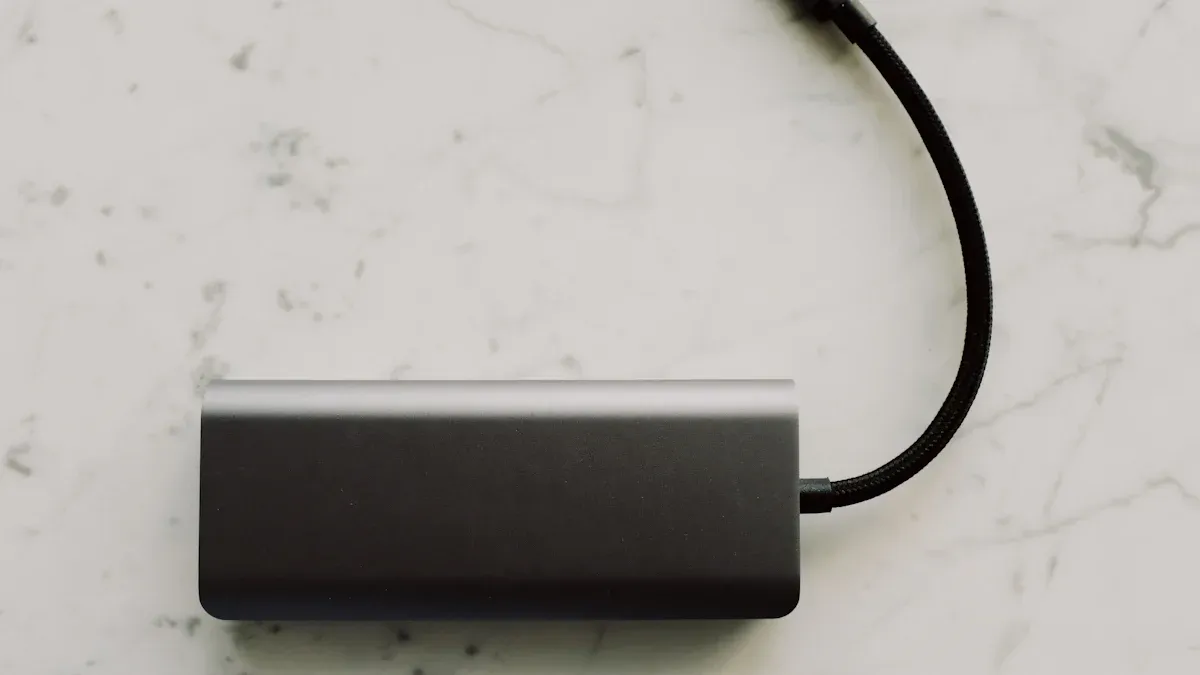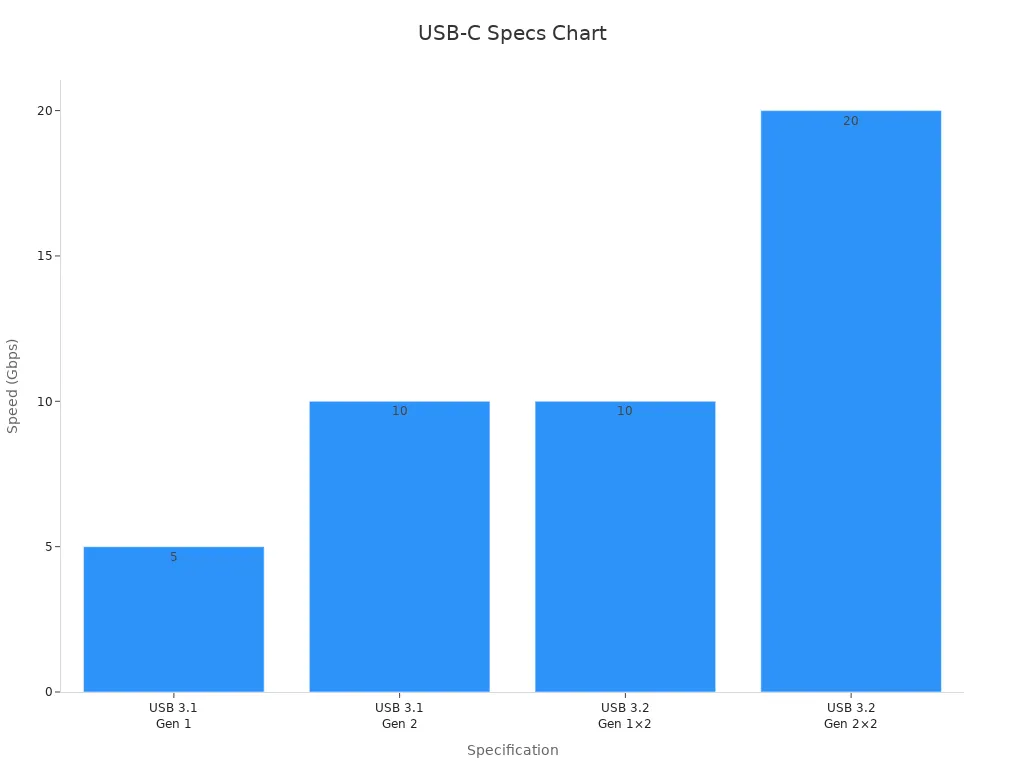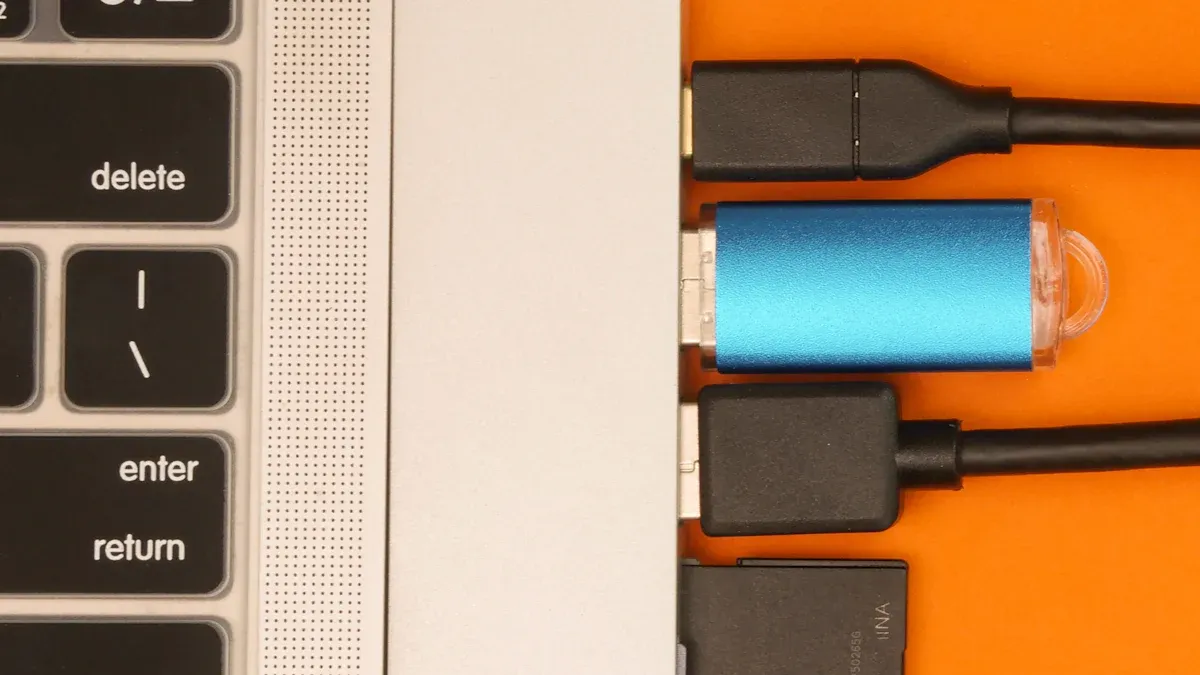USB-C to USB-C cables revolutionize how you power your devices. They deliver exceptional charging capabilities, supporting fast charging technologies with up to 240 watts of power, making them indispensable for modern gadgets. These cables also enable data transfer speeds of up to 10 Gbps, ensuring top-notch performance. The USB-C market, valued at $4.66 billion in 2024, is projected to grow exponentially, driven by its universal compatibility and efficiency. Choosing the right cable safeguards your devices while maximizing quick charge efficiency, giving you a reliable solution for your charging needs.
Understanding USB-C and Its Features
What Makes USB-C Unique?
USB-C stands out as a game-changer in the tech world. Unlike older USB types, it combines power, data, and video signals into one compact connector. Its symmetrical, reversible design makes it easy to plug in without worrying about orientation. This feature alone saves you time and frustration.
USB-C supports faster data transfer rates and higher power delivery capabilities. For instance, the USB Power Delivery 3.1 Type-C cable can deliver up to 240W of power. This allows it to adjust voltage and current based on your device’s needs, ensuring efficient and safe charging. Additionally, USB-C is compatible with a wide range of devices, from smartphones to gaming consoles, making it a universal standard.
USB-C and Power Delivery for Fast Charging
USB-C excels in fast charging due to its support for USB power delivery technology. This feature enables the cable to deliver up to 100W of power, making it ideal for charging high-power devices like laptops. Typical input voltages include 5V, 9V, 15V, and 20V, allowing the cable to adapt to various devices.
Fast charging with USB-C can be up to 50% quicker than traditional chargers. For example, you can charge your smartphone to 50% in just 30 minutes. This efficiency makes USB-C the preferred choice for users who need quick and reliable charging solutions.
Benefits Over Traditional USB Standards
USB-C offers significant advantages over older USB standards. It supports data transfer speeds of up to 10Gbps with USB 3.1 Gen 2, enabling you to transfer large files, like 4K movies, in seconds. Additionally, USB-C’s bi-directional power delivery allows simultaneous charging and data transfer, which is not possible with traditional USB cables.
The table below highlights the differences between USB-C and other USB types:
| Feature | USB-C | Other USB Types |
|---|---|---|
| Data Transfer Rate | Faster than other USB cables | Slower than USB-C |
| Power Transfer | Yes, on a single cable | Typically requires separate cables |
| Compatibility | High-performance devices | Limited compatibility |
| Video Output | Supported | Not supported |
USB-C’s ability to handle power, data, and video through one cable makes it a superior choice for modern devices. Its universal compatibility ensures that you can use it across multiple gadgets, simplifying your tech setup.
Why USB-C to USB-C Cables Are Ideal for Quick Charge
High Power Delivery for Fast Charging
USB-C to USB-C cables excel in delivering high power for fast charging. These cables support advanced power delivery technology, which adjusts voltage and current to match your device’s requirements. This ensures efficient and safe charging for a wide range of devices, from smartphones to laptops. With power delivery capabilities of up to 240 watts, USB-C cables can handle even the most power-hungry gadgets.
Fast charging becomes a reality with USB-C cables. For example, you can charge a smartphone to 50% in just 30 minutes. This makes them ideal for users who need quick charge solutions during busy schedules. The ability to deliver high power without overheating or damaging your devices highlights the superior performance of USB-C cables.
Superior Data Transfer Rates
USB-C cables are not just about charging; they also offer high-speed data transfer. These cables support impressive transfer rates, making them perfect for tasks like moving large files or streaming high-definition videos.
- USB4 cables can achieve speeds of up to 20Gbps.
- Thunderbolt technology allows for data transfer rates as high as 40Gbps.
- USB 3.1 Gen 1 supports speeds of up to 5Gbps, while USB 3.1 Gen 2 doubles that to 10Gbps.
These benchmarks demonstrate the unmatched efficiency of USB-C cables in handling data. Whether you’re transferring 4K videos or syncing files between devices, USB-C cables ensure you get the job done quickly and efficiently. Their ability to combine fast charging with high-speed data transfer makes them a versatile choice for modern users.
Universal Compatibility and Reversible Design
USB-C cables are designed with universal compatibility in mind. They work seamlessly across a wide range of devices, including smartphones, tablets, laptops, and even gaming consoles. This eliminates the need for multiple cables, simplifying your tech setup.
The reversible connector design is another standout feature. You no longer have to worry about plugging the cable in the wrong way. This saves time and reduces wear and tear on both the cable and the device’s port. Additionally, USB-C cables support multiple protocols, enhancing their versatility for both charging and data transfer.
These features make USB-C cables a future-proof solution. As more devices adopt USB-C as the standard, investing in these cables ensures you stay ahead in terms of technology and convenience.
Key Factors Affecting Charging Performance
Importance of Cable Gauge
The thickness of a USB-C cable plays a crucial role in its charging performance. Thicker wires, measured by a lower AWG (American Wire Gauge), carry power more efficiently. They reduce resistance, which minimizes heat generation and ensures better power delivery to your devices. On the other hand, thinner wires with a higher AWG increase resistance, leading to slower charging speeds and potential overheating.
Using a cable with a lower gauge allows you to maximize the power delivery from your charger. For example, pairing a high-power charger with a low-gauge cable ensures optimal charging speed without bottlenecks. This combination prevents the charger from reducing its output to avoid overheating, which can slow down the charging process.
Tip: Always check the cable specifications for AWG ratings to ensure efficient charging for your devices.
Impact of Cable Length on Efficiency
Cable length directly affects charging performance. Longer cables introduce more resistance, which leads to voltage drops and slower charging speeds. This resistance also generates heat, further reducing efficiency. For USB-C cables, organizations like USB-IF recommend keeping the length under 1 meter to minimize these issues.
Shorter cables deliver power more effectively, ensuring faster charging for your devices. If you need a longer cable, look for one with a lower gauge to offset the increased resistance. This balance helps maintain charging speed while accommodating your setup needs.
Note: When choosing a USB-C cable, prioritize shorter lengths for better efficiency and faster charging.
Ensuring Compatibility with Devices and Chargers
Not all USB-C cables support fast charging or high-speed data transfer. Compatibility with your devices and chargers is essential for optimal performance. Some cables are designed for basic charging, while others support advanced features like power delivery and high-speed data transfer.
To ensure compatibility, check the cable’s specifications. Look for certifications like USB-IF or Thunderbolt, which guarantee support for fast charging and data transfer. Additionally, verify that the cable matches your device’s power requirements. Using an incompatible cable can limit charging speed and even damage your devices.
Tip: Invest in certified USB-C cables to ensure safe and efficient charging for all your devices.
Choosing the Right USB-C to USB-C Cable
Certified USB-C Cables for Safety
When selecting USB-C cables, safety should be your top priority. Certified USB-C cables undergo rigorous testing to meet safety and performance standards. These certifications ensure that the cables deliver power efficiently without overheating or causing damage to your devices.
Two key certification standards to look for include:
| Certification Standard | Description |
|---|---|
| UL 9990 | Provides safety requirements to reduce risks of fire from poorly designed cables, non-compliant connectors, and inadequate current capacity. |
| USB-IF Compliance | Ensures that USB-C cables meet specific performance and safety criteria, including the mandatory use of E-markers and ratings for power transmission. |
Certified USB-C cables also comply with the latest specifications. For example:
– The latest USB-C specification emphasizes the use of E-markers in cable assemblies.
– Cables are now rated at either 60W or 240W, depending on their voltage requirements.
– The USB-IF discontinued certification for 100W USB-C cables in December 2021.
By choosing certified cables, you protect your devices from potential hazards while ensuring optimal charging performance.
Tip: Always check for USB-IF or UL certifications when purchasing USB-C cables to guarantee safety and reliability.
Matching Cable Specifications to Device Needs
Not all USB-C cables are created equal. Different types of USB-C cables offer varying levels of power delivery, data transfer speeds, and compatibility. Matching the cable specifications to your device’s requirements ensures you get the best performance.
Here’s a quick comparison of cable types and their capabilities:
| Cable Type | Specifications | Compatibility | Performance Benchmarks |
|---|---|---|---|
| USB-A | Supports USB 1.1 to USB 4.0 | Computers, power adapters, gaming consoles, etc. | Varies by USB version |
| USB-C | Transfers audio, video, data, and power | Universal connectivity | Up to 40Gbps (Thunderbolt 4) or 240W (USB PD 3.1) |
For high-speed data transfer and charging, consider cables like the Anker Thunderbolt 3.0. This cable supports Power Delivery and Qualcomm Quick Charge, with a maximum power rating of 100 watts. It also offers data transfer rates up to 40Gbps, making it ideal for Thunderbolt ports.
When choosing a cable, consider these factors:
– Power Delivery: Ensure the cable supports your device’s power requirements, such as 60W or 240W.
– Data Transfer Speed: Look for cables with USB 3.1 or Thunderbolt 4 for faster performance.
– Compatibility: Verify that the cable works with your devices, including laptops, smartphones, and gaming consoles.
Matching the right cable to your device ensures faster charging and seamless connectivity.
Evaluating Durability and Build Quality
Durability plays a crucial role in the longevity of USB-C cables. High-quality cables withstand daily wear and tear, ensuring consistent performance over time.
Durability tests provide valuable insights into a cable’s build quality. For example:
| Feature | Description |
|---|---|
| Cable Sheath | The rubber sheath of the Anker PowerLine II is smooth yet grippy, indicating durability and ease of use. |
| Testing Method | Cables were subjected to bending, twisting, and pulling to assess housing strength. |
| Longevity Evidence | The PowerLine II held up after more than a year of daily use, demonstrating its long-lasting build quality. |
| Charging Speed | Supports fast charging, capable of charging an iPhone 8 or newer to 50% in 30 minutes with a compatible charger. |
When evaluating a cable’s durability, consider the following:
– Material Quality: Look for cables with reinforced jackets or braided exteriors for added strength.
– Bend Tests: High-quality cables often undergo thousands of bending tests to ensure flexibility and durability.
– Connector Strength: Check for sturdy connectors that resist bending or breaking.
Investing in a durable USB-C cable saves you money in the long run and ensures reliable charging for your devices.
Note: Opt for cables that have passed rigorous testing, such as 10,000+ plug tests or 2,000+ bending tests, to guarantee long-term reliability.
Practical Advantages of USB-C to USB-C Cables
Faster Charging for Modern Devices
USB-C cables are designed to deliver faster charging for your devices. High-quality cables equipped with E-Marker chips ensure optimal performance by adjusting power delivery to match your device’s needs. This feature prevents overheating and maximizes charging efficiency. Substandard cables, on the other hand, can slow down charging due to high resistance.
Modern chargers work in tandem with USB-C cables to provide fast charging. For example, a compatible cable can charge your smartphone to 50% in just 30 minutes. This speed is ideal for busy schedules, allowing you to power up your devices quickly and get back to your day.
Tip: Always choose certified USB-C cables to ensure safe and efficient charging for all your devices.
Simplified Connectivity Across Devices
USB-C cables simplify your tech setup by offering universal compatibility. You can use the same cable to charge and transfer data across a wide range of devices, including smartphones, tablets, laptops, and gaming consoles. This eliminates the need for multiple cables, reducing clutter and making your life easier.
The table below highlights the practical advantages of USB-C cables in modern settings:
| Advantage | Description |
|---|---|
| High Data Transmission Speeds | Achieves speeds of up to 10 Gbps, suitable for data-intensive applications. |
| Long-Distance Capabilities | Can transmit data over distances exceeding 300 meters without loss of integrity. |
| Reduced Interference | Utilizes active optical technology to minimize electromagnetic interference during transmission. |
| Enhanced Reliability | Designed with protective measures like armored TPU for durability in various environments. |
This versatility makes USB-C cables a reliable choice for both charging and data transfer, ensuring seamless connectivity across your devices.
Future-Proofing Your Charging Setup
USB-C cables prepare you for the future of technology. With the increasing adoption of USB-C in new devices, you can reduce the number of chargers and cables you need. This shift simplifies your tech ecosystem and promotes sustainability.
- Smaller GaN chargers are becoming more efficient and affordable, offering versatile charging solutions.
- USB-C supports a wide range of power needs, from low-power gadgets to high-performance laptops.
- The EU’s mandate for USB-C by 2024 will drive widespread adoption, making it the universal standard.
By investing in USB-C cables, you ensure compatibility with future devices and technologies. This forward-thinking approach saves you money and keeps your charging setup up-to-date.
Note: Adopting USB-C cables now helps you stay ahead of technological advancements while enjoying faster charging and better performance.
USB-C to USB-C cables play a vital role in achieving quick charge efficiency. Their advanced charging capabilities and high-speed data transfer make them indispensable for modern devices. The growing USB-C market, projected to reach $3.5 billion in 2024, reflects their increasing adoption due to enhanced compatibility and performance.
Understanding factors like cable specifications and charging performance helps you make informed choices. Selecting the right cable ensures faster charging, protects your devices, and delivers long-term reliability. As consumer electronics continue to evolve, USB-C cables remain essential for efficient charging and seamless connectivity.
Tip: Always choose certified USB-C cables to maximize safety and performance.
FAQ
1. What is the difference between USB-C and USB-A cables?
USB-C cables offer faster charging and data transfer speeds. They support up to 240W power delivery and 40Gbps data rates. USB-A cables are slower and less versatile. USB-C also has a reversible design, making it easier to connect.
2. Can all USB-C cables charge laptops?
Not all USB-C cables can charge laptops. You need a cable with high power delivery, such as one rated for 60W or 240W. Check the specifications to ensure compatibility with your laptop’s charging requirements.
3. How do I know if a USB-C cable is certified?
Look for certifications like USB-IF or UL on the packaging or product description. Certified cables meet safety and performance standards. They often include features like E-Marker chips for power regulation and durability testing.
4. Do longer USB-C cables affect charging speed?
Yes, longer cables increase resistance, which slows charging. Shorter cables deliver power more efficiently. If you need a longer cable, choose one with a lower gauge to reduce resistance and maintain charging speed.
5. Are USB-C cables compatible with older devices?
USB-C cables can work with older devices using adapters. However, they may not support fast charging or high-speed data transfer. Check your device’s port type and compatibility before purchasing an adapter or cable.




